Home » Hunting Dogs » English Springer Spaniel: Breed Characteristics, Abilities, and History
English Springer Spaniel: Breed Characteristics, Abilities, and History
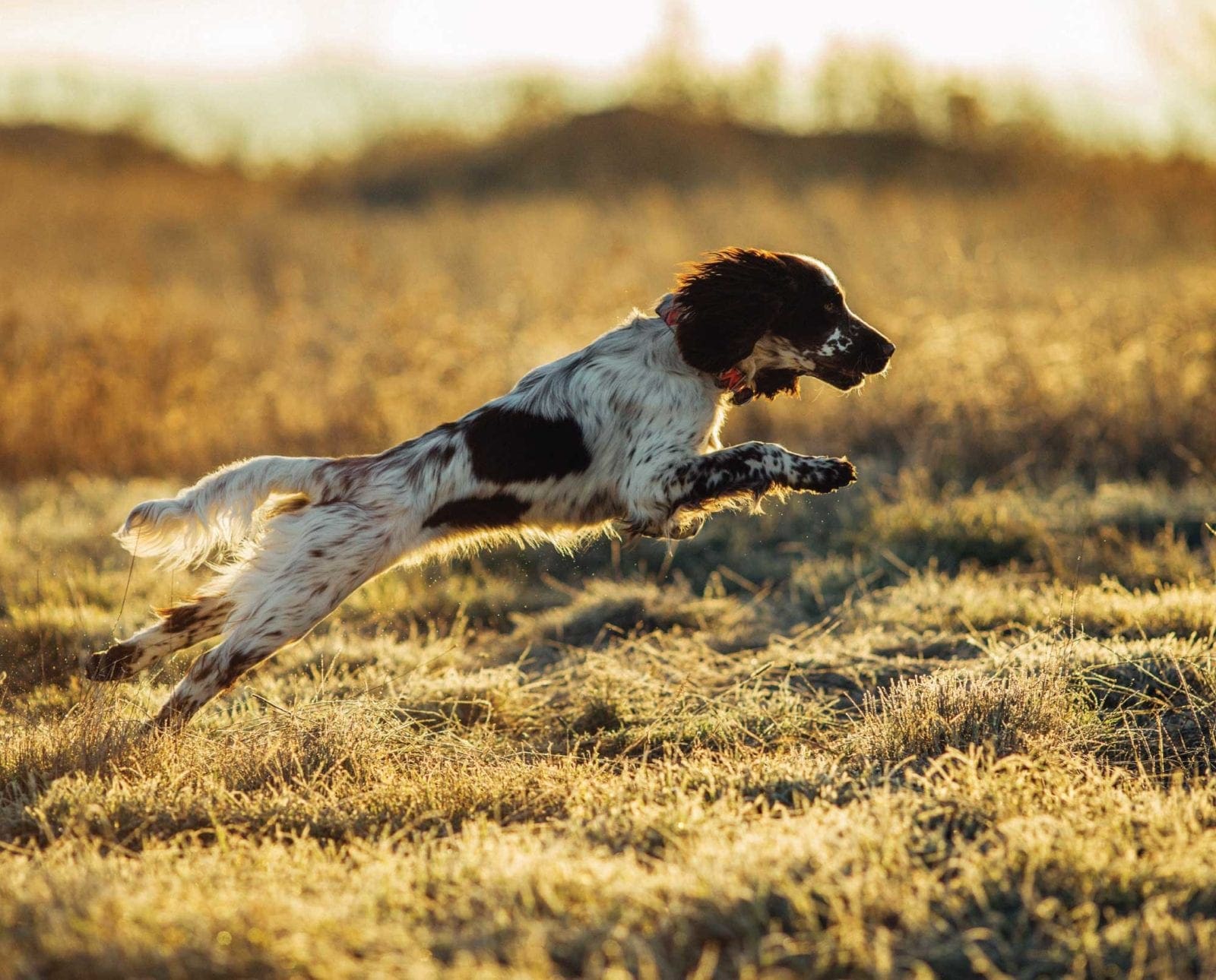
Johnathan Sliski is an educator by trade, Appalachian by upbringing,…
Explore the history, trainability, personality, and form of the popular flushing breed, the Springer Spaniel.
My first-ever interaction with an English Springer Spaniel was when my wife, Emily, brought one home. When considering which dog breed our first hunting dog should be, we ultimately landed on the one with which Emily was most familiar. She grew up with Springers, and consequently, that is where we landed. At that time, we weren’t aware of the differences between bench and field bred dogs. Perhaps unsurprisingly, as our involvement in bird hunting deepened, so did our knowledge of the breed.
Listen to more articles on Apple | Google | Spotify | Audible
Our first dog, Dixie, was most likely a bench bred dog. Bench bred dogs are those who are bred with the goal of placing in the show ring. I say most likely because she came from an inconspicuous farm litter but was physically more similar to a bench dog (we’ll get into that in a bit).
As Dixie got older, we got on a list for a field bred Springer Spaniel. These dogs are bred with the rigors of field trials and hunt tests in mind; hence the term field bred. Our first field bred dog, Timber, died from a gastrointestinal fungal infection before her second birthday. At that point, we got Fern. Then, roughly a year later, Wild, who has the same mother as Timber, joined our family.
Our experiences with Timber and our subsequent Springers introduced us to Cristy Joy, the current president of the English Springer Spaniel Field Trial Association (ESSFTA), which was founded in 1924. She has a wealth of knowledge regarding Springer Spaniels and shares a bit of it below.
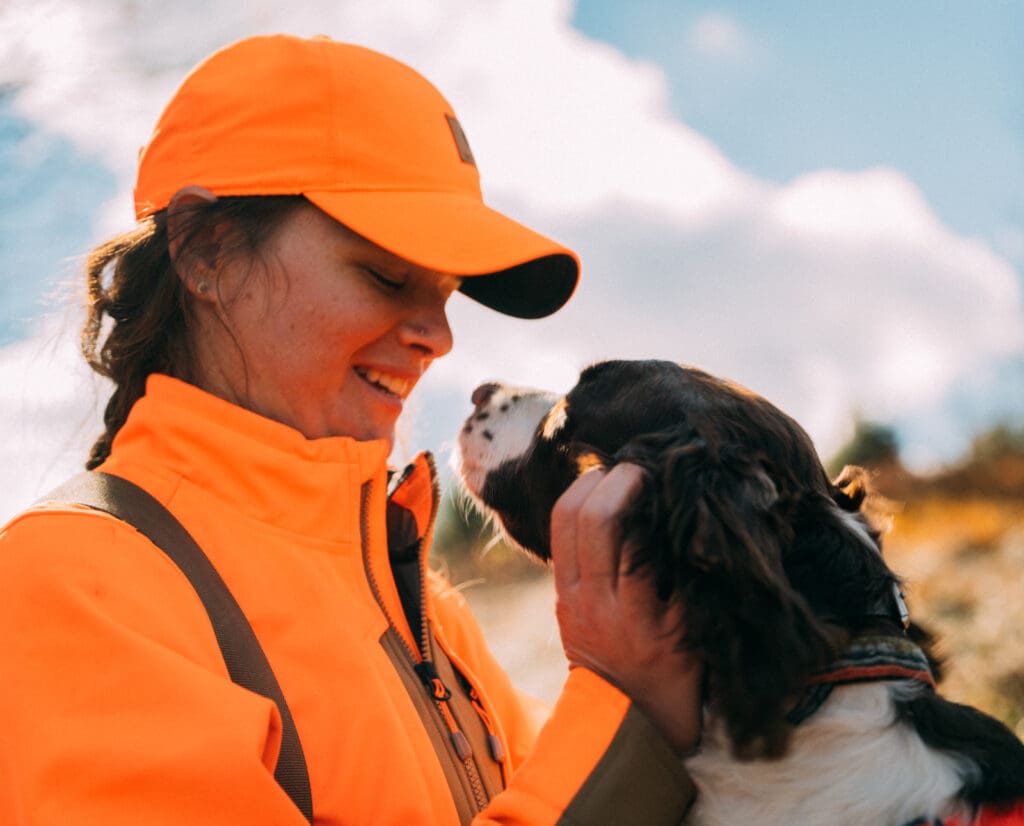
Springer Spaniel Characteristics and Form
| Characteristics | Details |
| Name | Pre-1902: “Springer” Post-1902: English Springer Spaniel |
| Size | Medium; 19-20” at the shoulders and 40-50 pounds, respectively. |
| Tail | Equal consideration to docked and undocked tails. Bench dogs are typically docked at ¼ length, while field dogs are typically docked around ¾ length. |
| Coat | Of moderate length with feathering behind the legs, ears, and tail. Varies in coarseness. |
| Coat Color | Liver/white; black/white; tri-color (either of the aforementioned with tan); blue or liver roan is also in the standard |
| Health Issues | Ear infections; some hereditary eye disorders; hip dysplasia and elbow issues |
| Character | Intelligent, biddable, eager |
| Population | AKC registered ESS each year average for the last 3 years is 4,516 |
| Range | Close; inside gun range |
| Pace | Quick |
| Good Choice For | Pheasant, typically, but will hunt grouse and woodcock |
English Springer Spaniels are a medium-sized breed. Female dogs bred for the show ring are ideally around 19 inches at the shoulders. Males are a touch taller at 20 inches. They range between 40 and 50 pounds, respectively. As with any dog, however, form and function exist in tension. It is possible to find field bred dogs that are of slighter stature than their bench bred counterparts.
Their coats are typically moderate in length and range in coarseness. Joy identified black and white, liver and white, tri-color (either black and white or liver and white with tan) as the AKC competition-approved colors for the Breed. In 1994, several colors were identified as alternate/non-standard colors that can be a registered, purebred English Springer Spaniel. They are rare and include lemon and white, orange and white, red and white with marking descriptions or a spotted or ticked roan.
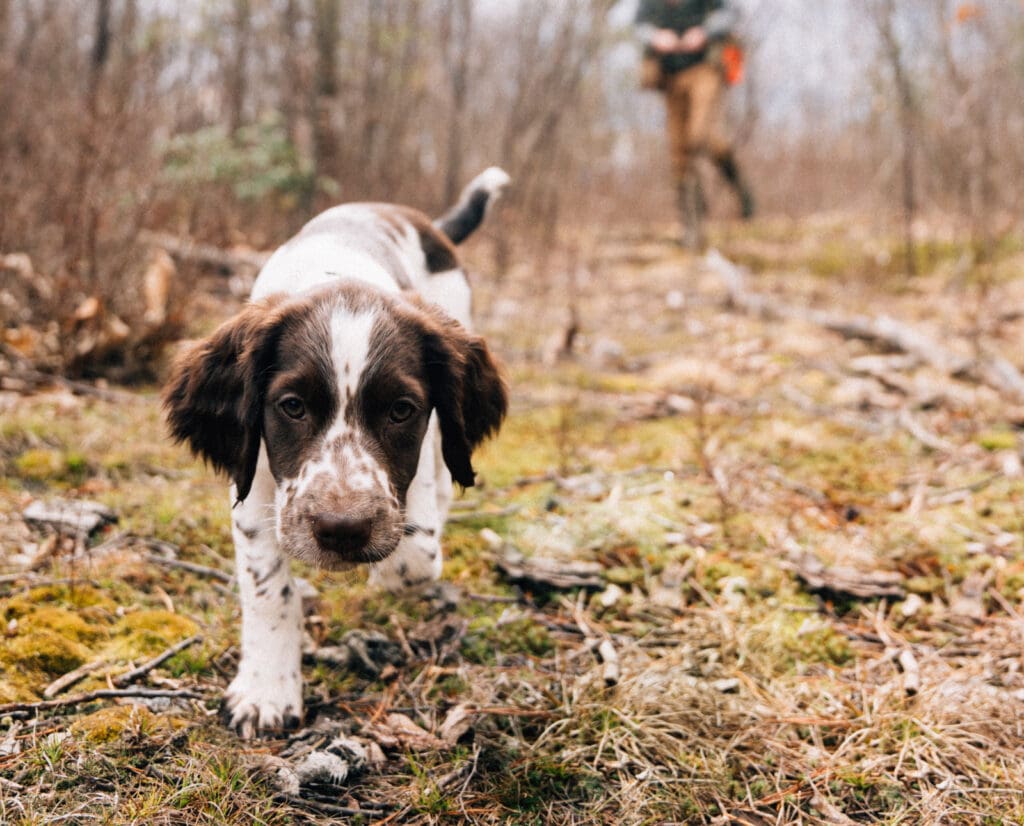
Tail length is not a consideration in shows. However, bench dogs in the United States typically sport tails docked around ¼ length. Their field bred counterparts are around ¾ length. In some countries where the docking of tails is illegal, the tails are obviously left intact. According to Joy, the AKC recently approved giving equal consideration to docked or undocked English Springer Spaniel tails in the USA conformation ring.
Perhaps the most appealing part of Springer Spaniels is their personalities. In Joy’s words, they are “fun-loving, aim to please, want to be your best friend all the time.” They are intelligent and eager dogs who enjoy being with their people. In the field, they are quick-running and cover ground efficiently with a natural quarter. They enjoy activities that are not only physically exerting but also mentally stimulating.
While the aspects of personality and biddability are present in all Springer Spaniels, you are far more likely to find the characteristics desired by hunters in field bred lines. Strong prey drive, a great nose, high athleticism, and more compact size, to name a few characteristics, are more congruent with the rigors of the field. The reality, according to Joy, is that, like all breeds, they are bred to meet specific goals. Field dogs are bred to meet the training goals of those engaged in hunting pursuits and, sometimes, specifically for field trials.

Springer Spaniel Training and Hunting Abilities
There are many fantastic resources available that deal with the specifics of training a Springer Spaniel from puppy to finished dog (see HUP!: Training Flushing Spaniels The American Way). With that in mind, however, it is important to note that this is a breed that enjoys activity of both a physical and mental nature. It is likely that you will find that 20 minutes of mental exercise is as effective in tiring your dog as 40 minutes of physical exercise.
Joy cites that a Springer’s biddability is a key component of both its trainability and hunting capabilities. “They perform best with a job,” she says, and she indicated that there are around 14 AKC-sanctioned events in which Springers can participate, and others outside of the AKC’s umbrella.
Springers hunt within gun range by necessity. They run with a natural quartering pattern that is easily honed to the hunter’s expectations. This pattern can have the appearance of a windshield wiper or can be permitted some creative freedom for the dog to use the wind to their advantage in locating game. Think of a figure eight-type pattern in which the dog’s outward cut is oriented to work back toward the hunter with the wind at its nose.
They are flushing dogs and, therefore, will not stop once they have located a bird. In fact, the opposite is quite true. Springers are supposed to flush birds hard. Finished dogs are trained to stop, or “hup” (Spaniel talk for sit), at the flush and be steady through shot and fall. As a dog with good retrieval instincts, it is vital as well that the dog be proficient in marking downed game and have the perseverance to locate and retrieve to hand.
The reality is that if the work requires biddability, a strong nose, and athleticism, they can likely be trained to do it. “Their range,” Joy says, “ranges from helping the United States Coast Guard get rid of vermin in shipping containers and ships to serving as therapy dogs.”
Field Search
As mentioned above, Springers work cover, whether field or wood, with intensity. They boast strong noses. That, combined with their quartering pattern and pace, means they can cover large areas with ease and, according to Joy, are fearless in cover. A dog’s flush should be of sufficient force and intensity that game is sprung well within gun range. Like all hunting dogs, those instincts can be further developed by their handle or trainer to meet their needs.
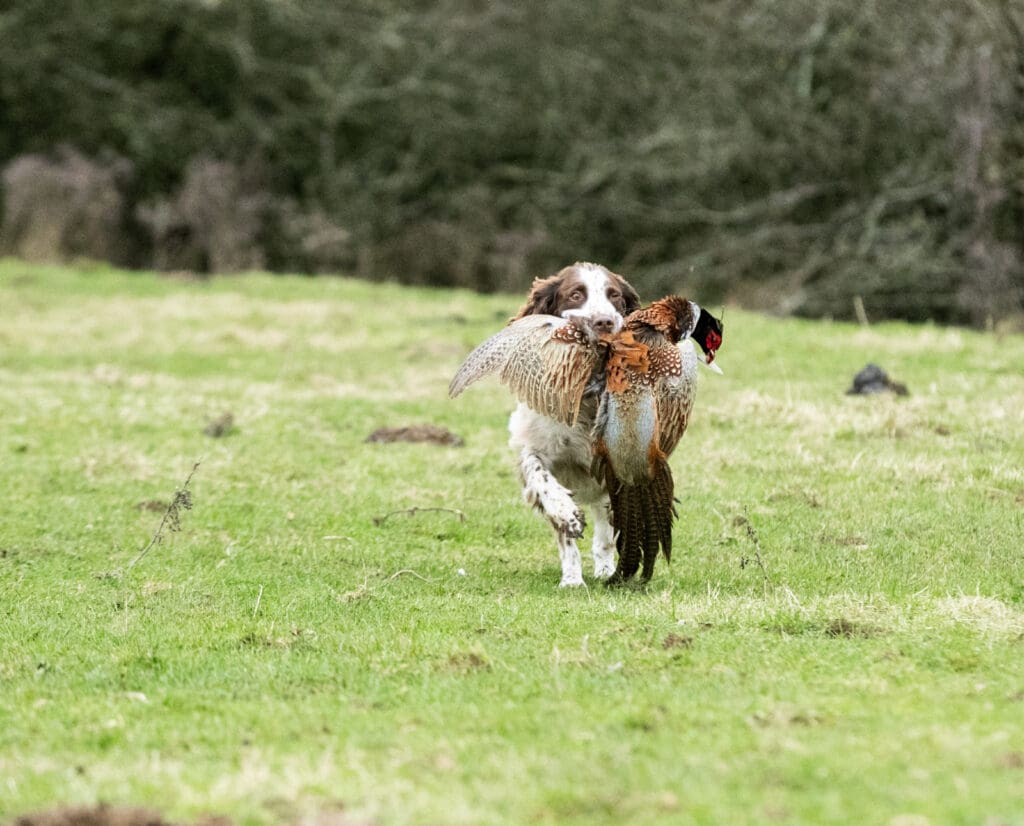
Retrieving and Water Work
Springers are flushing dogs that are natural retrievers for water work. According to Joy, retrieving is fast regardless of terrain or water–Springers fulfill their tasks enthusiastically. In field trials, for example, Springers are required to complete their retrieves as part of the scoring. According to Joy, “In order to be titled, Springers must pass a water test, which means completing back-to-back retrieves.” In referencing the Field Trial Rules and Standard Procedure for Spaniels from the AKC, Joy describes the water test as “two back-to-back, open water, 30-40 yard retrieves of dead ducks or dead pheasants with gunshot. The dog is to be backed up to 10 to 15 yards from the bank for its entry.” A soft mouth is a valuable trait in Springers, resulting in the returned game being undamaged.
As of 2022, Springers are permitted to run in AKC retriever hunt tests.
Flushing
If you have witnessed a pointing breed work, you have no doubt had the joy of watching a dog slam into a point, pinning a bird, which then holds until the hunter kicks up the bird for the shot. The dog, after the hunter flushes the bird, is ideally steady through the shot and fall of the bird.
Flushing dogs, in contrast, and as indicated prior, run in a quartering pattern in search of quarry. Upon location of game, they target that area until a bird is produced. The ideal flush is hard, putting the bird into the air. Finished dogs are expected to stop on the flush and be steady through the shot, mark the fall, and be released for the retrieve to hand.
Flushing dogs, by nature, must work within gun range. The entire premise of flushing is negated if the dog is hunting on his or her own outside of gun range. My personal comparison of the pointing breed equivalent of this is ripping birds (as opposed to bumping them carelessly).
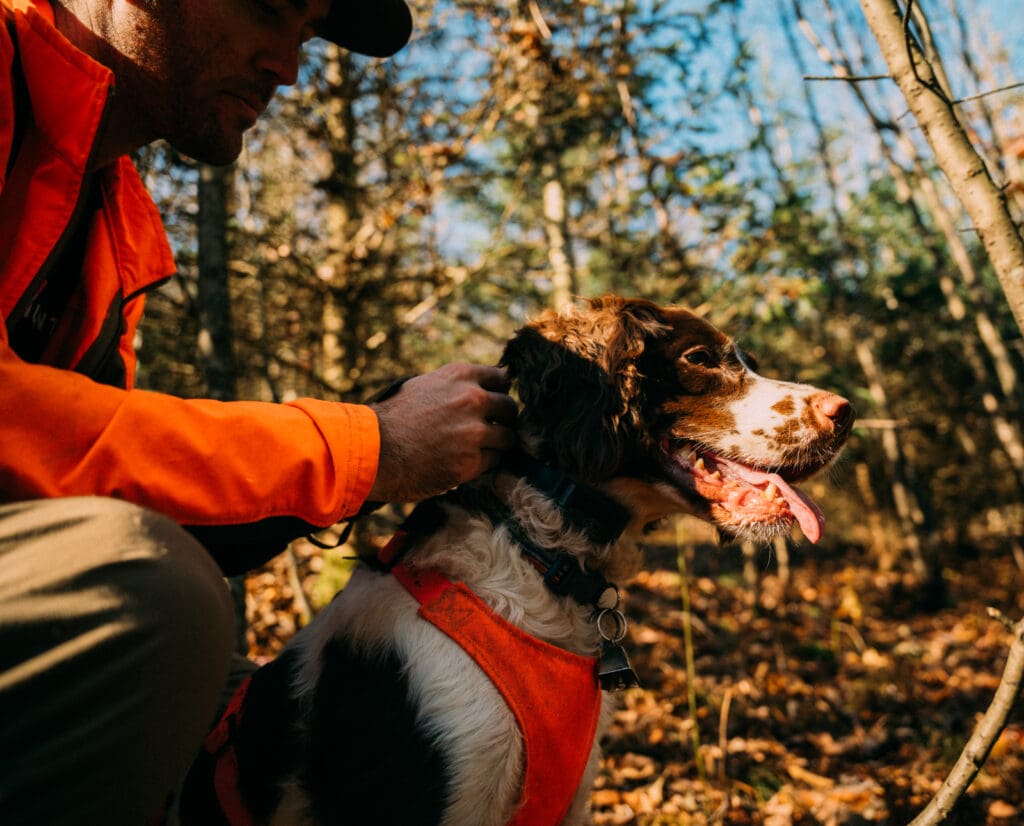
Springer Spaniel History and Development in America
According to the ESSFTA, Springers can trace their legacies back to the early common era in the British Isles and possibly originated on the European continent. Initially used in conjunction with hawks and falcons, they had great success in “springing” game for the birds. Advances in firearms made the dogs further suited for hunting pursuits.
Smaller dogs from these litters were, perhaps obviously, used for hunting woodcock. This approach ultimately led to the establishment of the Cocker Spaniel.
As their modern name implies, English Springer Spaniels were brought to the Americas from England in the early 1900’s. Under the guidance of the newly minted English Springer Spaniel Field Trial Association, dogs were showed and trialed. That approach persisted until the lines were effectively split by the mid-1900s. As an example, the last dual champion Springer, Green Valley Punch, won in 1938.
This more specialized approach to breeding created very distinct differences between bench dogs and their field bred counterparts.
The dogs continue to be popular in field trials and hunt tests across North America. While not, perhaps, as popular in certain locales as their pointing cousins, Springers can be found throughout covers, fields, and blinds. As mentioned above, over 4,500 dogs were registered with the AKC, on average, each of the last three years. Only 10 percent of Springer owners are members of the ESSFTA, a number Joy would like to see increase.
Springer Spaniel Clubs and Groups
- English Springer Spaniel Field Trial Association
- Eastern English Springer Spaniel Club
- English Springer Spaniel Club – UK
- Spaniel Club Français
- Spaniel Club Deutschland e.V.
- https://www.birddogfoundation.com/
Events with ESSFTA National Support and Awards
- Match Shows
- 4-6 Month Beginner Puppy
- Puppy of Achievement
- National Owner Handled Series
- FSS Open Show
- Public Service Dog
- Barn Hunt
- Disc Dog
- Diving Dogs
- Flyball
- Search & Rescue
- Parent Club Title Recognition
- Field Events for Hounds
- Coursing, CAT & FAST CAT
- Herding & Farm Dog
- Scent Work
- Spaniels & Flushing Breeds
Johnathan Sliski is an educator by trade, Appalachian by upbringing, and bird hunter by sheer dumb luck. Born and raised in East Tennessee, he has long been enthusiastic about the outdoors. Moving to Central Pennsylvania allowed that passion to find a new outlet in hunting and fishing, but specifically in bird hunting with flushing dogs. Johnathan lives with his wife, Emily, and their two Springer Spaniels, Dixie and Fern.




Field Bred English Springers and Cockers have th he first 1/3 of their tails docked. Show bred springers and cockers leave only 1/3. It is a very important distinction when looking for a reputable breeder who can help find the right match for you.
You have to prove to me the who, what, when and why of “how to dock a springer’s tail.” Is this a commandment someone found in stone somewhere: “DOCK ONLY THE FIRST 1/3….” I think this is a personal choice only. I think springers with long tails are ugly.
Jeff, you are absolutely right it is a personal choice. However their are traditions on both sides. On the field bred side a tail that is left un docked can be prone to injury; however, docking it a bit shorter, only removing the first third, with a preference for a white tip has throughout history shown to be beneficial. A springer will become very animated when on game, birds or rabbits. The tail can help the hunter recognize this behavior. And a longer tail makes for more visibility when questing. It also is an indication that the breeder has held true to the tradition of the breed and has bred for hunting traits, and conformation. Not for a certain coat color, pattern, or arbitrary appearence. A tail that is docked down to leaving only 1/3 is a dog that has been bred for appearacne or those unfamiliar with what a true field bred springer is and what traits have been coveted and chosen to bring about the wonderful natural instincts of the dog. A show bred dog has long been removed from a program selecting for these qualities. And if you compare the two, they are very diffrent looking in apperance, and it is obvious to see how form has followed function.
In short, the length of the tail is a very good indication of what type of springer it is. Is it one bred selectively for a century for one purpose or the other. It can also be an indicator of a dog bred out of ignorance of the centuries of progress with no real purpose to better the breed.
Jeff, The shorter tail on the bench bred is more about show than hunting. The longer 2/3 tail in the purpose of hunting line is for the handler to better see tail reaction to bird scent. Docking in and of itself is to reduce injury when hunting heavy thorny cover. I have a 13 year old female field bred that has a short tail. Some field trial judges did have negative comments about it. But I never cared she is an AKC Master hunter and a HRC 500 point champion retriever. I have a 10 foot wall in my home office lined with her ribbons metals and trophies.
I’ve been an ethical breeder of Field-bred English Springer Spaniels for over 40 years. This article was ok at best. To say “Field Springers have a fairly good retrieving instinct” is not only an insult to the breed but 100% incorrect. In addition she leaves out the most important genetic issues suck as PFK and Retinal Dysplasia. This article was obviously written by someone not at all knowledgeable about Field-type Springers. It’s peppered with information about Bench-type Springers. And doesn’t even mention Field Spaniels. Please do some more research before you decide to write articles. Thanks so much. Jim owner and operator of Briar Ridge Springers
Relax Jim. Who cares how long you been breeding! Just great to see an article on spaniels, when everything seems to be on labs theses days
They say ignorance is bliss…..
I have to say I am glad Field bred ESS don’t have the following and popularity like labs. The last thing we need is a silver springer LOL.
No matter which tail style you choose, when you have a springer that has all of the positive traits, then you have a great dog that is to be cherished for a lifetime. I have owned field springers for more than 45yrs. and have had memorable moments with each and every one of them.
They are truly a pleasure to train and appreciate!!
Nothing against a 2/3 dock, but the length of the tail has zero influence on the dogs ability and doesn’t make you any better of a hunter.
Pay attention to the breeder and lineage. A good springer shows you a lot more in the field than the last inch of white hair on its tail.